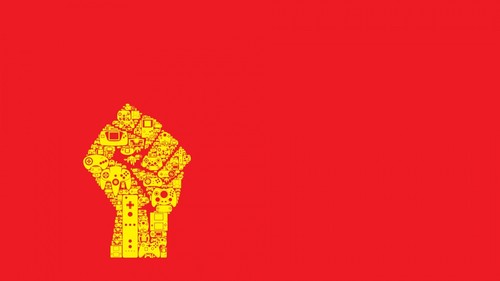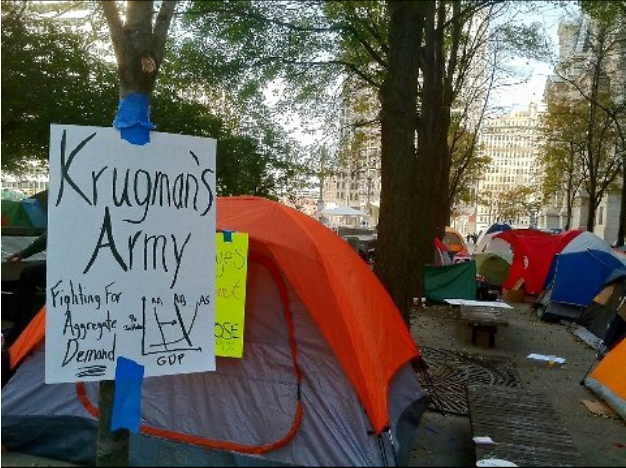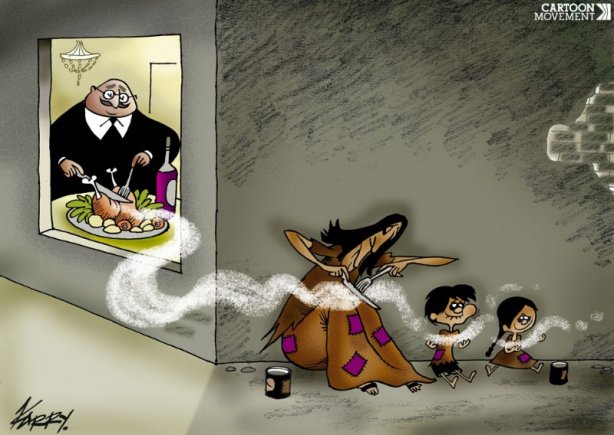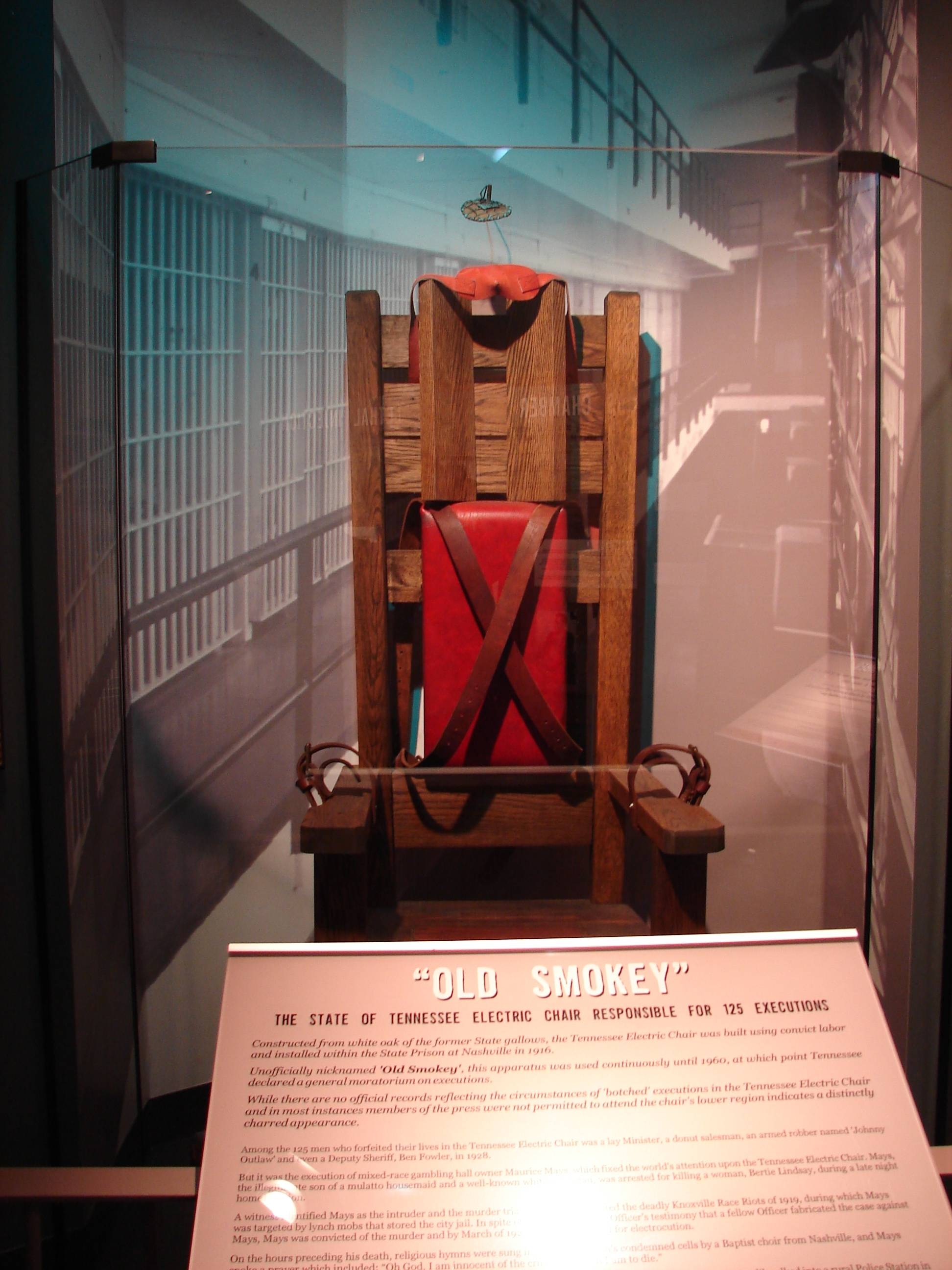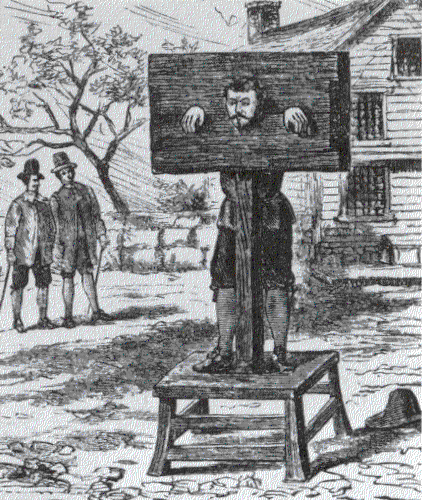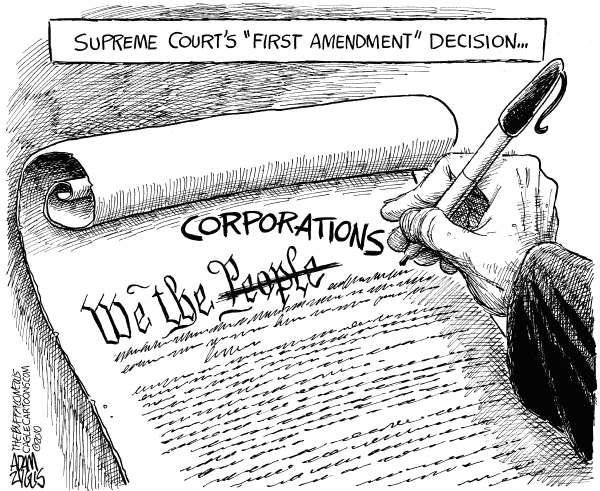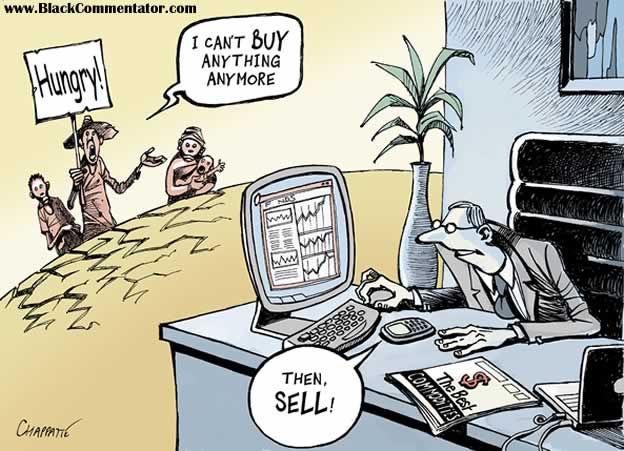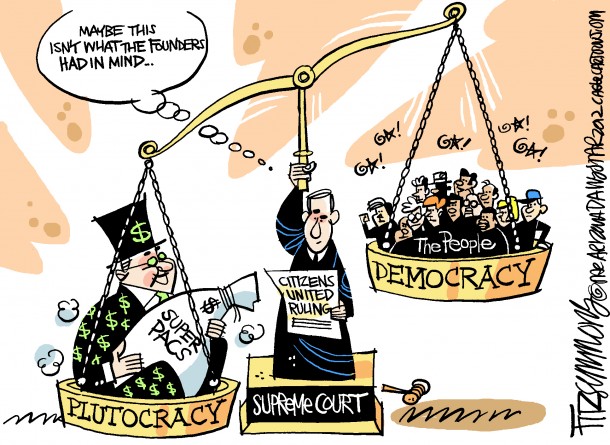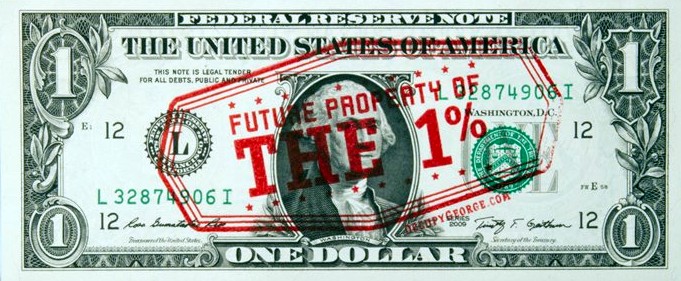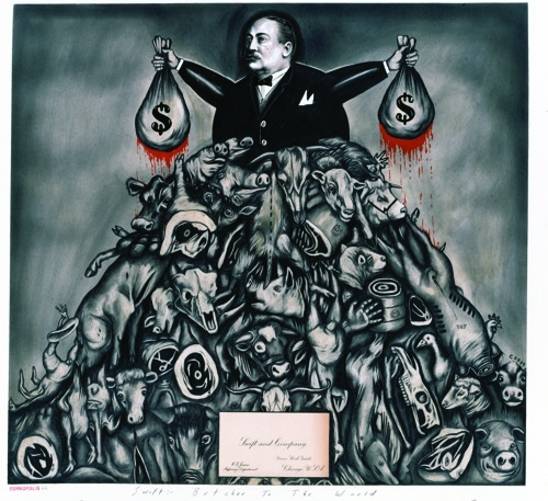Crime, punishment and the limits to power
by Shimshon Bichler and Jonathan Nitzan
In May 2011, the U.S. Supreme Court ordered the State of California to release 30,000 to 40,000 of its 140,000 inmates.[1] California’s prisons have become so overcrowded that the Supreme Court declared the situation unconstitutional. The decision was imminent. For nearly two decades, California, along with many other states, was busy getting ‘tough on crime’. In the early 1990s, the state enacted the ‘Three-Strikes Law’, which mandates life sentences for third-time serious crime offenders, and it pursued the country’s ‘war on drugs’ and other law-enforcement campaigns with increasing zeal. Soon enough, its prisons were overflowing at nearly twice their capacity.
The United States is often portrayed as the archetypical liberal model. It is the world’s largest, most prosperous ‘free market’ and the greatest generator of profit on earth. And yet this very liberal haven is also the largest penal system in the world. There are now more than two million inmates in its prisons and jails and another five million on probation and on parole. If you add these two numbers together, you get a ‘correctional population’ of over seven million. This correctional population is the largest in the world – both absolutely and relative to the overall population – and it is also the largest the country has ever seen.
To some, this combination of market prosperity and intense punishment may seem puzzling. Many people intuitively expect crime and punishment to correlate with poverty, backwardness and deprivation; to be a feature of the Third World, not the First.
Knowingly or not, this expectation is grounded in the conventional separation of production from state and capital from power. According to the liberal version of this separation, accumulation breeds economic prosperity, and prosperity in the economic sphere reduces crime and calls for less punishment in the socio-political sphere. However, if we discard this separation and instead think of capital as power, and of capitalism as a mode of power, the puzzle disappears. The greater the capitalization of power, the greater the resistance to that capitalization and the larger the force needed to prevent this resistance from exploding. As profits increase to make distribution more unequal, the result is mounting resistance from below, and this resistance in turn leads to retaliation from above. The rising crime and intensifying punishment that we now see in the United States are key manifestations of this dialectic of capitalized resistance and retaliation.
The Questions
The purpose of this presentation is to examine the issue of crime and punishment within the larger context of capitalized power, and specifically in relation to the limits of such power.
This exploration continues the line of argument we developed in two previous Forums held here at York. In the 2010 Forum, we introduced the concepts of systemic crisis and systemic fear. We claimed that the current crisis – which started not in 2008 but in 2000 – is systemic, and that capitalists are now concerned not so much about employment, production or even profit, but the very survival of their system.[2]
Then, in the 2011 Forum, we examined the ‘Asymptotes of Power’. Capitalists in general and dominant capitalists in particular, we argued, have objective reasons to fear for their system. We showed that the present distribution of income-read-power – ranging from the most aggregate indicators of the national accounts down to the differential earnings of dominant capital – is pushing against its class limits. And we suggested that, if the pushing continues, it could trigger systemic collapse.[3]
This presentation examines the darker side of this struggle. In the past, resistance to capital was associated with production, workers, left political parties, strikes and mass demonstrations. But as the world changed, new forms of resistance and retaliation have emerged, and the ones we will look at today are crime and punishment. We will start with the two charts that ended last year’s presentation – charts in which we related the distribution of income and capital on the one hand with the extent of state punishment on the other.
Figure 1 shows the income share of the top 10 per cent of the U.S. population. This share offers a proxy, however imperfect, for the power of the ruling class and the thick power belt that supports it. The shaded areas in the figure denote two historical extremes – periods during which the income share of the top 10 per cent of the population exceeded 45 per cent. During the 1930s, this share approached 47 per cent of total income. And in retrospect, that level proved to be the asymptote of capitalist power. Pushing against it triggered a systemic crisis, followed by the complete creordering of the U.S. political economy and a sharp decline in capitalist power, proxied here by a large drop in income inequality. The situation now is remarkably similar, both quantitatively and qualitatively. During the 2000s, the income share controlled by the top 10 per cent of the population approached 48 per cent, a level whose attainment and sustainment required the ruling class to subject the underlying population to increasing doses of violence, pain and sabotage.
Figure 2 illustrates one key manifestation of this process – and the difficulty of sustaining it. The chart reproduces the distributional measure from Figure 1 and contrasts this measure with the adult ‘correctional population’, expressed as a share of the overall population. The correctional population comprises adults in prison, in jail, on probation and on parole. And as the chart shows, the ‘correctional’ share of the population is tightly and positively correlated with the distributional power of the ruling class: the greater the power, the larger the dose of violence inflicted on the underlying population. Presently, almost 2.5 per cent of the U.S. population is under some sort of institutional punishment – which, as indicated, is the largest proportion in the world and highest in the country’s history. Although there are no hard and fast rules here, it is doubtful that this massive punishment can be increased much further without highly destabilizing consequences. The 2011 Supreme Court order to release 30,000 to 40,000 prisoners is perhaps a sign that the ruling class is apprehensive of such a destabilization; and the apparent peak in both income inequality and the correctional population suggests that capitalist power may be approaching its asymptotes and that a systemic reversal could be in the offing.
Now, let us focus on the correctional population. In Figure 3, the black series at the bottom denotes the correctional population as a share of the overall population (which we take from Figure 2). The top red series shows the annual rate of change of the bottom series. Historically, this rate of change has fluctuated between −10 and +10 per cent, and the question we need to ask is what drives these changes: Why did the correctional population remain fairly stable till the late 1970s? Why did it soar during much of the neoliberal 1980s and 1990s? And why did it level off in the 2000s?
Georg Rusche
Until the 1930s, these types of questions were never asked, let alone answered. The subject of crime and punishment was studied mostly by novelists, legal experts, doctors, psychologists, philosophers and moralists. It was rarely if ever dealt with by political economists, and it was certainly never studied scientifically.
The first to undertake this type of study was the German political economist Georg Rusche.[4] Rusche was born in 1900 and received his PhD in economics in the mid 1920s. He was interested in labour economics, and he also became involved in prison work. This background led him to contemplate the connection between punishment and the labour market. In the early 1930s, he was commissioned by the Frankfurt School to write a book on the subject, and in 1933 he produced a short article, titled ‘Labor Market and Penal Sanction’, where he spelled out his thesis. Six years later, in 1939, he published, together with Otto Kircheimmer, the full manuscript, titled Punishment and Social Structure.[5]
According to Rusche, crime and punishment were too important to be left out of political economy. They needed to be anchored in economic theory, he said, and they had to be embedded in the evolution of class relations and class conflict. What were the basic propositions the researcher should start from? Rusche offered four.
The first proposition – which today may sound like a liberal triviality – concerned the goal of the penal system. Crime consists of acts forbidden by society, and one of the purposes of the penal system, Rusche posited, is to limit and reduce those acts.
The second proposition – which nowadays may ring like a mainstream cliché, but back in the 1930s sat well with the materialist emphasis of Marxist analysis – had to do with Bentham’s ‘calculus of pleasure and pain’. In order to deter crime, the penal system needs to convince people that ‘crime doesn’t pay’; in modern economic parlance, we would say that it needs to make the expected pain from punishment greater than the expected gains from crime.
The third proposition identifies what we may call the ‘asymptotes of penality’. Most people disposed to crime come from the lower strata of society, where the conditions of life are the hardest. This fact means that in order to deter crime, the penal sanction must be worse than the living conditions of these lower strata. ‘If the prison doesn’t underbid the slum in human misery’, Rusche quotes Bernard Shaw, ‘the slum will empty and the prison will fill’.[6] In other words, the lowest living conditions in society set the upper limit of the penal system.
The fourth and final proposition concerned the rate of unemployment. Many factors affect the living conditions of the lower strata, says Rusche. But the most important by far is the labour market, and particularly the ‘excess supply/demand’ for labour, or the rate of unemployment. When there is ‘excess supply’, unemployment rises and wages decline, causing crime to increase and punishment to intensify. And when there is ‘excess demand’ and unemployment decreases, the opposite process is set in motion.
These observations, which Rusche says hold in every society, set the general boundaries of penality.
When labour is abundant, deprivation is close to its limits, so the unemployed can be deterred from crime only by the ultimate punishment: death. Rusche gives the example of China, where a huge reserve army of unemployed makes human life worth close to nothing. Under those conditions, he observes, it is common for captured criminals to be executed without much fuss.
By contrast, when labour is scarce and there are not enough workers to fill all the jobs, the penal system shifts toward reform and exploitation. The goal now is not to prevent the hungry from criminal acts, but to convince unwilling labourers and criminals that they need to be working. This situation, says Rusche, existed for example during the European Enlightenment of the seventeenth century, when ‘excess demand’ for labour ushered in by the Mercantilist Era brought prison reforms. Moreover, since ‘excess demand’ for workers drives wages up, it became profitable to lock up criminals and use them as forced labour, and that too was a feature of European Mercantilism. All in all, a tight labour market causes the system to move from execution to exploitation.
Now these are the two logical extremes: death on the one hand, penal reform and forced labour on the other. A political economy of crime and punishment, says Rusche, needs to start from this analytical skeleton and then flesh out the real historical process that Disraeli referred to as the ‘two nations’ and Marx called the ‘class struggle’. The first person to offer such analysis was Rusche.
Rusche’s own work was largely historical and comparative. He went through a series of epochs, examining in each case (1) the conditions of the labour market; (2) the nature of crime; and (3) the intensity of punishment. And what he found was largely consistent with his hypothesis.
During the early Middle Ages, land was abundant and the population sparse. Most crime was about passion rather than property, and punishment usually took the form of revenge, penance or monetary fines.
In the late Middle Ages, land grew scarcer and the population more abundant. There were peasant wars and social unrest, and armies of beggars became commonplace. Property crime and robbery were on the rise, but criminals were often unable to pay, so punishment grew crueler and execution more common.
During the Mercantilist period, roughly the seventeenth century, wars, hunger and plagues reduced the population, while trade raised the demand for workers. Labour became scarcer and wages increased. It was in this context that the Enlightenment movement made punishment more humane and that imprisonment emerged as a new venue to exploit forced labour.
In the Industrial Revolution, roughly the eighteenth century, mechanization made workers abundant, wages fell and the reserve army of the unemployed swelled. Forced labour was no longer necessary, and prison conditions became punitive and grew harsher.
In America till the late nineteenth century, rapid industrial development, abundant land and a relatively small population made labour scarce and wages high. The crime scene accorded with Rusche’s hypothesis: criminal offences were low; prison reform was in full swing; conditional sentences, parole and probation were increasingly used; and scientists began to study the causes of crime and how welfare policies can abate them.
Rusche also provided an interesting comparison between the United States and Germany during the 1930s. In America, he said, massive unemployment and weak unions drove wages down, causing the penal system to become more overcrowded, brutal and repressive. In Germany, in contrast, the presence of strong labour unions mitigated the decline of wages and helped moderate penal sanctions.
Finally, Rusche was also prescient in predicting the use of concentration camps to solve the labour shortages created by the rearmament drives of totalitarian regimes.
The Puzzle
Rusche himself received little recognition in his lifetime and committed suicide in 1950. Although he offered a very impressive starting point for what was then a totally new approach, for a long time his work remained largely unknown and did not make it to the mainstream of either criminology or sociology, let alone political economy.
It was only in the 1980s, with soaring U.S. crime and the massive increase in incarceration, that his approach finally gained some traction, particularly in the critical literature. Also, there were now more systematic data to study, and with computing becoming cheaper, critical sociologists and radical criminologists started to subject Rushe’s hypotheses to various empirical investigations.
But then there arose a puzzle. Whereas Rusche’s long-term historical hypotheses seemed to shed light on various epochs and lead to derivative theses and theories, the conclusions from shorter-term analyses, particularly of contemporary Western societies, were more ambiguous.
The breakdown happened around the 1980s. The central axis of Rusche’s argument is that penality should be positively correlated with ‘excess supply’ in the labour market. Most researchers take the rate of unemployment as the key proxy for ‘excess supply’ of labour and the share of the overall population under ‘correction’ as the proxy for penality. These two proxies are plotted in Figure 4 – unemployment on the left scale and the correctional population on the right. Now, the chart shows that until the early 1980s the two proxies were correlated positively (though by no means tightly). However, from the early 1980s onward, this correlation breaks down completely. With Ronald Reagan in office and neoliberalism in full swing, unemployment declined – yet the correctional population went vertical. On the face of it, then, it would seem that the Rusche thesis was loosely valid until the beginning of neoliberalism, but not afterwards.
Re-search
In our view, though, this would be a hasty conclusion to draw. It seems to us that, at any point in time, penality should be proxied not by the overall level of the correctional population, but by their current rate of change. The reason is simple. The overall level of the correctional population is determined by two factors: (1) the cumulative results of past crime and punishment; and (2) current crime and punishment that cause this cumulative result to increase or decrease. The current rate of unemployment affects only the second of these factors; it influences not the past levels of crime and punishment, but its rate of change.
Figure 5 reflects this shift in emphasis, and the effect is dramatic. The figure shows the same rate of unemployment as in Figure 4. But penality now is proxied not by the level of the correctional population relative to the overall population, but the annual rate of change of this ratio. There are two important things to note in this chart.
We can see that, for much of the past century, changes in the U.S. correctional population were almost perfectly ‘explained’, at least statistically, by changes in the rate of unemployment. Rusche was right – indeed more right than he could have anticipated. According to the figure, there is no need for complicated models, multiple variables and assorted excuses (when the models fail). The two forms of sabotage – unemployment and penality – mirror each other almost perfectly.
But there are two important exceptions to the rule – the first occurred during the Great Depression of 1930s, the second in the present crisis. During both of these systemic crises, which the chart shades in grey, the two series are not positively, but negative correlated. In both, unemployment rises sharply – but penality, instead of soaring in tandem, decelerates sharply or actually falls.
So we have an enigma. If our interpretation of Rusche is correct, then what explains the decoupling of unemployment and penality during systemic crises? Is this a mere coincidence, or do systemic crises alter the underlying relationship of the two processes? We return to this enigma at the end of the presentation.
Decompose
Let us try to make sense of these two observations. The first step is to decompose the rate of change of the correctional population. Consider Equation (1), where the dots on top of the variables indicate temporal rates of change. In this equation, the rate of change of the share of the correctional population in the overall population is approximately equal to the rate of change of the correctional population less the rate of change of the overall population.
Now, if the rate of change of the overall population is fairly stable, variations in the share of the correctional population in the overall population (the left-hand side of the equation) will be dominated by the rate of change of the correctional population (first element on the right).
So let’s decompose the rate of change of the correctional population. Mathematically, this rate of change comprises three components: (1) the intensity of punishment, proxied by the change in the correctional population relative to crime; (2) the crime rate, measured by the ratio of crime to the overall population; and (3) the correctional population as a share of the overall population. The decomposition is given by Equation (2):
Crime and Punishment
Let us look more closely at the numerator of the third line of Equation (2), beginning with the crime rate. Figure 6 shows the historical evolution of what the FBI calls the ‘serious crime rate’. Serious crimes include criminal homicide, forcible rape, robbery, aggravated assault, burglary, larceny-theft and motor-vehicle theft.[7] The FBI collects these statistics from various sources, standardizes them and expresses them as a ratio to the overall population. For example, in 2010, the serious crime rate was 334 for every 10,000 people, or 3.3 per cent. Note the cyclicality of the serious crime rate. It rose from its nadir of 2 per cent in 1960 to a peak of 6 per cent in 1980. At that point, criminologists, social commentators and politicians thought that all hell was breaking loose, that the crime rate was likely to shoot through the roof, and that the social fabric of the U.S. was about to disintegrate.[8] None of these predictions have materialized. Instead of rising, the crime rate started a long-term decline, and by 2010 it was half as high as it was in 1980.
Unfortunately, we do not have unified serious crime statistics for years prior to 1960. But we do have data for the murder rate, depicted here in red. The number of murders of course is much smaller than the overall number of serious crimes. In 1980, for instance, for every 10,000 people there were 600 serious crimes but only one murder. The key for our purposes, though, is that the two series are highly correlated. And if this correlation also held prior to 1960, it implies that the U.S. crime rate has followed a fairly stylized long-term cycle.
Bearing this cyclicality in mind, we can move to Figure 7. The thick black line in the figure measures the serious crime rate per 100 people. The chart also shows the intensity of punishment, proxied by the thin red line. If you look at Equation (2), you can see that this intensity is measured in two steps. The first step is to compute net change in the correctional population. For example, in 2010 the correctional population fell by 157,000. This figure represents, for that year, the number of people who were caught, tried and sentenced, less the number of those released. For 2010 the net figure was negative – there were more people leaving the correctional system than entering it. The second step is to divide this net change by the number of serious crimes reported that year and multiply the result by 100. This computation gives us the net change in the correctional population per 100 crimes. In 2010, this ratio was −1.5, which means that for every 100 serious crimes, there were 1.5 people deleted from the correctional population. By contrast, in 1998 the number was +3.2, which means that for every 100 serious crimes, there were 3.2 people added to the correctional population. Note that this is a ‘composite measure’ that reflects four different processes: (1) the efforts and the effectiveness of the police; (2) changes in the legal code; (3) the harshness of the courts; and (4) the release rate of those previously sentenced.
The chart shows that the two measures – crime and the intensity of punishment – are tightly correlated. Now, recall that, according to Rusche, crime and punishment are both driven by conditions in the labour market – particularly unemployment – so the correlation between them suggests we should examine their separate relationships to unemployment.
Figure 8 shows the relationship between the serious crime rate and the unemployment rate since the 1960s. In general, the data seem consistent with Rusche’s hypothesis, at least until recently. They show the two processes to be moving in tandem, rising until the 1980s and receding afterwards. But by the late 2000s, the relationship between unemployment and crime seems to have broken down: while unemployment has risen sharply, the crime rate, instead of increasing, has continued to drop.
Figure 9 shows the relationship between the intensity of punishment and unemployment. And the patterns here are similar to those in Figure 7. There is a positive relationship between unemployment and the intensity of punishment, with both rising till the 1980s and falling afterwards. And here, too, the relationship inverts in the late 2000s: while unemployment rises dramatically, the intensity of punishment drops sharply and indeed becomes negative. Note that the short-term correlation since the 1980s is looser than before; but even in this looser correlation, the divergence between the series in the late 2000s stands out clearly.
Taking Stock
What do these relationships mean for capital as power and for the limits on that power? To contextualize our conclusions, let us reiterate our earlier findings. In the 2010 Forum, we noted that this is not a regular crisis but a systemic crisis, and that it is not a crisis of production or finance, or of a mismatch between them, but a crisis of power. The ruling class, we said, is struck by systemic fear – that is, fear for the survival of capitalism. The reverberations of crime and punishment – including the recent Supreme Court order to release a quarter of California’s prisoners – may be signs of that fear.
In the 2011 Forum, we outlined the objective ‘asymptotes of capitalist power’. The ruling class, we said, is fearful for a reason. The logic of capital as power is deterministic. It forces dominant capitalists to accumulate differentially and augment their power. They have no choice in this matter. They have to push toward the asymptotes of their power, relentlessly. And as they get closer to those asymptotes, their push elicits counter forces, making systemic collapse increasingly likely.
We have looked at the dark side of this process – the side of resistance. In the past, most analyses of resistance were anchored in the productive process. The focus was on industrial strikes, workers, mass movements and political parties. This ‘materialist’ focus was subsequently challenged by the ethno-cultural revolution. Instead of the old myths of the enlightenment and socialism, there arose a new emphasis on power and postism. Subjective deconstruction substituted for history’s ‘laws of motion’. Determinism was discredited, but so was meaning and significance.
Our own work breaks with this postist fashion. Autonomous resistance – such as the May 1968 uprising in France or the first Palestinian Intifada of 1987/8 – does not abide by the logic of capital and therefore cannot be analyzed from within that logic. But most resistance to capital as power is not autonomous, but heteronomous: it does not initiate – it responds; it is less an action and more a reaction; it is not external but integral to the conflictual logic of capital as power. In short, it is part and parcel of the capitalist mode of power, and that embeddedness makes it amenable to objective, deterministic inquiry.[9]
In order to engage in such inquiry, though, we need to transcend the conventional frame of reference. Most critical researchers continue to separate the capitalist reality into ‘production’ and ‘power’. In this framework, the labour market is part of the economy and accumulation, while the penal system is part of the state and the socio-political system more broadly. Rusche sought to challenge this view: he tried to analyze penality in relation to both production and discipline, and unemployment in relation to both criminality and the economy. But working within the Marxist frame of reference, he continued to think of capitalism as a mode of production. So his attempt, however ingenious, remained focused on material conditions and therefore was incomplete.
From the viewpoint of capital as power, penality and unemployment are not distinct aspects of politics and economics, respectively. Instead, they are different forms of capitalized resistance and sabotage. Human creativity is a positive form of resistance to capitalist power, and the threat of unemployment is the means by which the ruling class tries to strategically sabotage and subjugate this creativity to capitalist ends. Similarly with crime and punishment. Illegality is a negative form of resistance to capitalist power, and penality is the major institution that keeps this resistance from undermining the capitalist creorder.
These forms of resistance and sabotage fit into the breadth and depth regimes of capital as power.[10] In the past, we argued that during a depth phase, the sabotage of stagflation (stagnation and inflation) assists the process of ‘accumulation through crisis’.[11] Now, since crime and punishment are tightly correlated with unemployment, we can see how this additional form of sabotage kicks in. During the depth phase of the 1970s and 1980s, unemployment and inflation increased, as did crime and punishment. Conversely, during the breadth phase of the 1990s, they all decreased.
And here we come to the enigma of Figure 5. During the systemic crises of the 1930s and 2000s, the tight correlation between penality and unemployment seems to have broken down: in both periods, the sabotage of unemployment rose sharply; yet crime and punishment, instead of rising in tandem, actually receded.
What could explain this enigma? One possibility is that some of the data we use are incorrect or inaccurate. A second possibility is that our top-down presentation of the data is too crude, and that a more refined set of proxies for unemployment, crime and punishment will eliminate the anomaly. But there is also a third, substantive, possibility, and that is that systemic crises alter the rules of the game. These crises not only dent the resolve of the ruling class; they also change the class disposition of criminals. Under the system of ‘business as usual’ (including its cyclical crises), the poor feel that there is ‘no way out’. Without jobs, without dignity and with little prospect for change, the only alternative is crime. But during a deep, systemic crisis, there emerges another, transformational, alternative. This alternative is based not on individual alienation and protestation, but on class solidarity; not on defying the system but on altering its very structure. Perhaps it is the emergence of this democratic opening during a systemic crisis that causes crime to drop despite soaring unemployment.[12]
Endnotes:
[1] Supreme Court of the United States. Edmund G. Brown, Jr., Governor of California, et al., Appellants v. Marciano Plata et al. 563 U. S._ (2011). On Appeal from the United States District Courts for the Eastern District and the Northern District of California, May 23, 2012; Adam Liptak, ‘Justices, 5-4, Tell California to Cut Prisoner Population’, The New York Times, May 23, 2012.
[2] Shimshon Bichler and Jonathan Nitzan, ‘Systemic Fear, Modern Finance and the Future of Capitalism’, Monograph, Jerusalem and Montreal, July 2010, pp. 1-42; Andrew Kliman, Shimshon Bichler and Jonathan Nitzan ‘Systemic Crisis, Systemic Fear: An Exchange’, Special Issue on ‘Crisis’, Journal of Critical Globalization Studies, No. 4, April, 2011, pp. 61-118.
[3] Shimshon Bichler and Jonathan Nitzan, ‘The Asymptotes of Power’, Real-World Economics Review, No. 60, June, 2012, pp. 18-53.
[4] Rusche’s biographical sketch in this paragraph draws on Dario Melossi, ‘A New Edition of Punishment and Social Structure Thirty-Five Years Later: A Timely Event’, Social Justice, Vol. 30, No. 1, Spring, 2003, pp. 248-263.
[5] Georg Rusche, ‘Labor Market and Penal Sanction: Thoughts on the Sociology of Criminal Justice’, Translated by Gerda Dinwiddie, Crime and Social Justice, No. 10, Fall-Winter, 1978 (originally published in 1933); Georg Rusche and Otto Kirchheimer, Punishment and Social Structure, with a new introduction by Dario Melossi, New Brunswick, NJ: Transaction Publishers, 2003 (originally published in 1939).
[6] Rusche, 1933, p. 4.
[7] U.S. Department of Justice, Federal Bureau of Investigation, Uniform Crime Reporting Statistics, UCR Offense Definitions.
[8] See for example, Steven D. Levitt, ‘Understanding Why Crime Fell in the 1990s: Four Factors that Explain the Decline and Six that Do Not’, Journal of Economic Perspectives, Vol. 18, No. 1 (Winter), 2004, pp. 163-190.
[9] On the difference between the heteronomy of capital and the autonomy of resistance, see Jonathan Nitzan and Shimshon Bichler, Capital as Power: A Study of Order and Creorder, RIPE Series in Global Political Economy, New York and London: Routledge, 2009, pp. 19-21.
[10] Jonathan Nitzan, ‘Regimes of Differential Accumulation: Mergers, Stagflation and the Logic of Globalization’, Review of International Political Economy, Vol. 8, No. 2, 2001, pp. 226-274.
[11] Jonathan Nitzan and Shimshon Bichler, The Global Political Economy of Israel. London: Pluto Press, 2002.
[12] The third possibility was suggested to us by the Israeli criminologist, Professor Jacob Reuven.
Note: This is the edited transcript of a paper presented at the 3rd Annual Forum on “Capital as Power: Capitalizing Power: The Qualities and Quantities of Accumulation”, York University, Toronto, 28-30 September, 2012 (http://bnarchives.yorku.ca/341/).
[Thank you Jonathan for permission to post this here. This is also the first anniversary of Philosophers for Change and we thank all contributors for their support and commitment]
Shimshon Bichler teaches political economy at colleges and universities in Israel. Jonathan Nitzan teaches political economy at York University in Toronto. Their most recent book, Capital as Power: a study of Order and Creorder (2009), is freely available, along with all their other publications, from The Bichler and Nitzan Archives.
